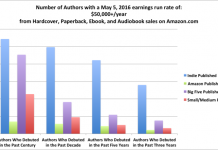
From a blog article in FUTUReBOOK. You should read the full piece, in which Atkinson proposed that the rental, or subscription, model might be the future of ebooks and would benefit publishers, libraries and readers. Atkinson speaks with some authority as he is Head of Digital for Hardie Grant Publishing (AU, UK, NZ) and based in Melbourne, having previously been Digital Marketing Manager at Borders UK.:
…
but here are some ideas that could form the basis of a workable subscription model, that unlike Kindle lending, doesn’t terrify most publishers.
- Retailers agree to pay publishers a ‘lending rate’ per view, different to standard discount terms.
- As Amazon is doing, allocate a proportion of the overall subscription revenue and apportion it on the basis of the selling price of the products and the amount of times they get loaned. Restrict the number of concurrent loans any user can have based on the subscription rate paid so that the people borrowing more books contribute more to the pot of revenue.
- Reciprocal contra (seriously) – publishers can pay to invest in featuring titles (as normal) but retailers can also pay a higher rate of return on those titles – fortune favouring those publishers brave enough to invest in promotion. Publishers supporting retailers and vice versa.
And the benefits?
- Less risk for the consumer choosing to test out a new author or genre (rather than buying what they know as is the current trend)
- A steady increasable and renewable revenue stream from committed readers for publishers and retailers
- Limitless pre-orders
- Growth of WOM in ebooks
- Opportunities for resourceful publishers to increase readerships and revenue
- A more level playing field for retailers (with range being key)


































The one group that subscriptions doesn’t benefit is independent authors; in fact, this provides one more way for major and established publishers to shut out the indies from the rest of the public.
Subscriptions also tend to lock subscribers into only the products being offered by the subscription services. The minute that a desired book comes out that is not part of the subscription service, subscribers start jumping ship so as not to limit their purchasing options.
There is no *one* future. I can see subscriptions as one of many viable options. I’m not aware that subscription has been terribly successful in any other area. Why would anyone suggest that it should be *the* future? Most people prefer to make their own choices, not make choices from limitted offerings decided by some invisible person or corporation.
Firstly Catana is correct. The idea that ‘one’ model is the future is misguided. There are many many ways to skin a cat.
I suggest to everyone that there is still a fundamental mistake in the perception of reading in a digital age, among far too many people coming from the paper age, in this business.
In the paper age, a book was a physical product. A desired product. A product that transcended the written contents and included the physicality of the paper, the cover, the cover art etc. Readers bought a book and then put it on a shelf as a permanent reminder that they had read it. A reminder to themselves and those around them. A ‘trophy’ as someone recently put it (bizarrely, imho). Nevertheless this sense of the continued ‘enjoyment’ of the ‘book’ has been part of our culture for a long long time.
Arising out of this culture came the concept of ‘borrowing’ a book. of course during the period of ‘borrowing’, the actual contents was fully consumed. Yet the concept of this ‘borrowing’ was perpetuated by the above behaviour of keeping and displaying and enjoying the mere presence of the book. It is in this
I would suggest to one and all that the digital world is fundamentally different. The physical paper is gone. The paper is gone. The cover art is essentially gin, especially as a ‘display’ item. The whole practice and experience of keeping a book and displaying it for oneself and/or others to observe is gone. Once the reader buys the eBook and reads/consumes it, that is the end of the experience.
When it comes down to it, the whole basis for the concept of borrowing is gone! What does borrowing mean anymore ? What is the difference between buying and borrowing in a digital world ? Both result in the contents, the actual part that results from hundreds of hours of toil and talent, being consumed. Yet many people are still persisting with this outdated and inappropriate borrowing idea.
The fact is that the world of publishing, of writing is moving on, away from books to eBooks.
The appropriateness of lending is obsolete. The very concept is obsolete. A reader consuming a writer’s work is a reader consuming a writer’s work! whether borrowed or bought. The sooner people grasp this and realise that it makes NO sense whatsoever for publishers or retailers to continue to support this borrowing model.
The future is simply affordable eBooks.
Subscriptions and renting do get around some of the ethical issues that our current sold-but-not-really-yours business model creates. Hardware restrictions and technological changes mean that an ebook you’ve bought isn’t yours in the same sense that a physical book is. The format may not be supported in the future. You can’t loan it to a friend. You can’t sell it used.
At least a subscription or rental model makes clear what a buyer is getting: a personal, temporary ability to read the book.